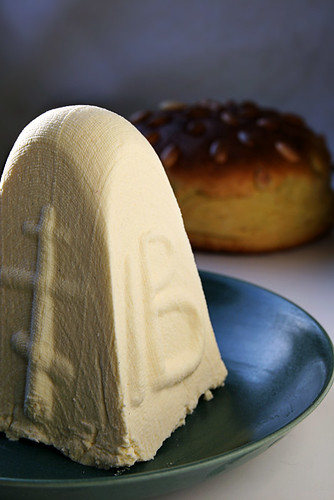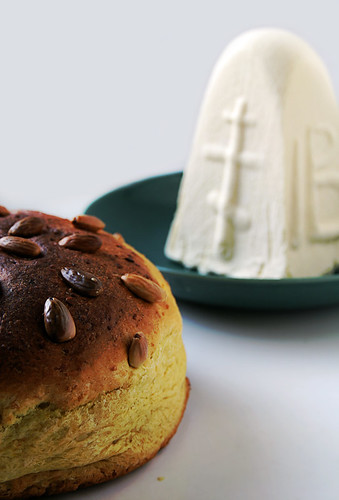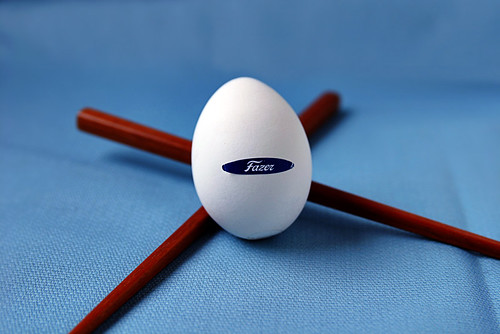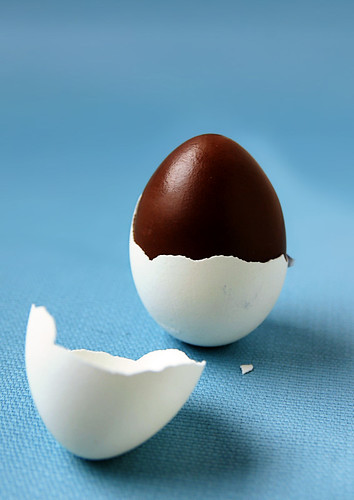Pasha, kulitsa & mämmi / pasha, kulitsa & memma
Easter is one of the seasons when you really feel the Russian influence on Finnish food traditions: mämmi, a truly strange-looking (and tasting, it has to be said) malted rye pudding, is our own, but paskha and kulich are both of Russian Orthodox origin.

My aunt supposedly tried to make mämmi herself once (read more about making it at Axis of Ævil) and never repeated the experience, and quite frankly, I'm not that wild about it (nor do I have enough people to serve it to to make it worthwhile), but paskha, a creamy, eggy, buttery, Lent-busting quark concoction is easy to make as well as yummy, and so it gets made every year. I've used a fine sieve to drain it in previous years, but this year I am in charge of THE paskha and got to use my aunt's wooden mould, decorated with Orthodox crosses.
Almost every recipe available would have you contaminate this fabulously tangy-creamy dish with either raisins, candied lemon peel, crushed almonds or a combination of the above. I'm going to flout public opinion here and state that they are wrong. And not just because I hate raisins.

We usually have our paskha spread on top of slices of plaited sweet pulla bread, but this year I was inspired to try out the saffron-scented round kulich instead. I'm borrowing the form from Marianna* but deviating a bit from her great-grandmother's recipe in favor of a firmer, more conventional dough, mostly because I didn't have the time to do otherwise.

To cap this post off (I'm heading out to our cottage in just a few minutes and won't be back until Monday, so happy Easter!), here is a Mignon - the quintessential Finnish chocolate egg. It looks just like a regular egg, you may think, and that's because it is - Fazer has sold these nougat chocolate-filled egg shells since 1896.

*whose Nordic Recipe Archive I really can't recommend enough - her recipes aren't necessarily exactly like the ones I use, but they always seem right. Besides, she agrees with me on the evil of crunchy bits in paskha. So there.
Paskha
600 g quark (look for tvorog in East-European specialty shops or make your own)
150 g sugar (I used about 50 g from my vanilla bean repository and the rest normal caster sugar)
200 g butter, softened
3 egg yolks
200 ml thick cream
Drain the quark in cheesecloth or a coffee filter overnight. If you're using a wooden mould, soak it overnight.
Whip the butter and sugar until light and creamy. Add the egg yolks, one at a time, still beating. Mix in the quark and, you guessed it, beat some more. You want everything to be smooth and airy.
In a separate bowl, whip the cream until it's thick and heavy. Fold it into the buttery quark mixture (no more beating!).
Line your mould (or strainer, sieve) with a single layer of dampened cheesecloth and spoon in the paskha batter. Fold the edges of the cheesecloth over the paskha, top with a plate or two for weight, and place in a bowl (to catch the drippings). Refrigerate for about 24 hours, then unmould and serve spread over slices of kulich or other sweet bread.
Kulich
25 g yeast
200 ml milk
pinch of saffron
1 egg
100 ml sugar
about 425 g all-purpose flour
100 g ground almonds
125 g softened butter
almonds for decoration
1 egg for eggwash
Heat the milk until it's lukewarm and dissolve the yeast and saffron in it. Mix in eggs and sugar, then ground almonds and finally about 375 g of the flour. Stir with a fork until everything is evenly mixed, then add the softened butter. Work in the rest of the flour, kneading until you have a soft, springy dough.
Let rise in a covered bowl for about half an hour, then shape into a flat disc about the size of your cake mould. Line the sides of said mould with buttered parchment paper that comes a fair bit over the edges of the mould (but not so high it won't fit in the oven *cough*), transfer dough to it. Cover with a towel and let rise for another half-hour.
Decorate with whole almonds, brush with the lightly whipped egg (er, I totally forgot), and bake at 200°C for about 30-35 minutes. Cool on a rack, then keep wrapped in foil, cutting slices to serve with paskha.
Har smakat mämmi hos en kompis när jag växte upp. Hennes mamma kom från Finland och bjöd på det. Pinsamt tyckte kompisen, men rätt ok tyckte jag. Men din paskha ser väldigt snygg ut. Kul att läsa om. Hoppas att det går bra att jag skriver på svenska. Glad påsk!
ReplyDeleteBeautiful pictures! But I so disagree with you on the paskha questions. I guess because here in Estonia we eat so much plain curd cheese throughout the year, that during Easter we really want those raisins, craisins, almonds, etc in our paskha to make it more festive:-)
ReplyDeleteGlad påsk! I´ve tried mämmi once and it was... kind of special. A Finnish collegue insisted serving it with fat milk (in a bowl), and I could see why since it added a "smoothness" to the whole dish.
ReplyDeleteThe paskha sounds yummy, would love to try it.
And the chocolate egg is great! How strange we don´t have it in Sweden? Never heard of it, but Fazer is well known here. Calls for investigation!
Thank you for another beautiful post. I thought I would de-lurk in time to wish you a Happy Easter and what I imagine is a similar Spring celebration of the start of the North's long sunny days. In any event - I love your site, and I am constantly appreciative of the magical things that you do with the staples I can generally rely on finding on my tundra island in the Alaskan Bush. Now, I know I can't buy quark. But I'm definitely looking forward to experimenting how I can make something similar with what I can find.
ReplyDeleteHi there, you have a beautiful blog with wonderful photography. I will have to come back for more. :)
ReplyDeletewonderful! I'm such a huge fan of curd cheese, but usually eat it plain on egg noodles with butter and poppy seeds. I've never head of mixing it with all those delicious things... thank you for the recipe and the knowledge.
ReplyDeleteNässelblom & choklad - jo, det går hur bra som helst på svenska! Memma är lite... tja. Jag äter nog lite varje påsk, med socker & grädde, och inte smakar det illa, ju, men nog är det en ganska... intressant smak.
ReplyDeletePille, it's OK, I know I'm in the minority here! And I do agree that "contaminated" paskha looks a lot more festive, it's just the texture I object to.
Ullis, it *is* ...special. I like it in limited portions, and with cream to go with, but I don't really expect anyone who wasn't born to it to go for the taste. And not getting Mignon eggs (which is like Fazer's crowning glory, never mind the boring Blue) is a travesty!
Aileen, thank you! I think you could probably get something similar with some sort of curd cheese, if you can find it. Or maybe a mixture of cream cheese (the saltiness might be a problem though) and very well-drained sour cream?
Rasa Malaysia, thank you!
Ann, I think its fabulous to find out how differently different cultures deal with fairly basic ingredients. (For example, over here cardamom is strictly used in sweet buns - I only started using it in savory dishes when I got into cooking Indian food.)
Deinin, what an education in food! Congrats on getting to use your aunt's mold, stuff like that is so cool! Hope you had a great time away this weekend, maybe even making something fun. Chow!
ReplyDeleteps: can I purchase one of the chocolate eggs online anywhere? I figure it might be a tad cheaper than a visit to the factory.
Monkey Wrangler, I didn't have much luck Googling for Mignon Eggs outside Finland. If you want to, hit me with your address (my email is deinin-at-gmail.com) and I'll see if I can still find some to send you.
ReplyDelete(Ullis, this goes for you, too, if you read this.)
Deinin I can't thank you enough for this post! I pretty much grew up in my Finnish neighbors' house and loved paskha and kulich at Easter even though I had no idea what they were. Your blog brings many happy memories back to me!
ReplyDeleteDoes anyone have any suggestion as to where I could find a paskha mould? I have found only one online and it is very square and not triangular. I would love to taste paskha again! :)
PS I also agree with you on the raisins. No way!
My Parents are from Estonia and I use my grandmother's Pasha recipe - which consists of -
ReplyDelete1lb quark type or curd cheese
1/2 lb butter
3 hard boiled egg yolks
1 cup sugar
1 1/2 vanilla beans chopped fine
1/4 cup each of :
chopped pistachios , sultana raisins and currants
he soaks the chopped vanilla bean in a few tablespoons of brandy or rum
we decorate our pasha with a red rose ( real one)right on the top and a red satin ribbon around the bottom, which makes it look very pretty for the easter table.
I really appreciate the blog since the first time do I saw it. Now they have reached another milestone which lead us to report about it, and I think it's a great new... as the content of the text.
ReplyDeleteEaster is excellent because that's the time I enjoy a lot, because all my family meet during that celebration, I want Easter coming soon because I can't wait for meals my grandmother prepares.
ReplyDeleteHi I really like your post, thanks for all the information, the recipe is amazing
ReplyDeleteThanks for taking the time to discuss this, but I am firmly convinced of this and love to learn more about the subject. If possible, acquire knowledge, would you update your blog with more information? It is very helpful to me
ReplyDeleteTerimakasih banyak gan informasinya sangat bermanfaat, jangan lupa yak mampir dulu ke website saya .....
ReplyDeletePenyakit Diabetes Melitus
Penyakit Diabetes Melitus Tipe 1
Penyakit Diabetes Melitus Tipe 2
Penyakit Diabetes Melitus Pada Ibu Hamil
Penyakit Diabetes Melitus Pada Lansia
Blog nya bagus dan bernilai edukasi tinggi...kunjungi website saya juga ya kawan....
ReplyDeletePenyakit Diabetes Melitus Pada Usia Muda
Penyakit Diabetes Melitus Pada Kehamilan
Penyakit Diabetes Dan Insipidus
Penyakit Diabetes Melitus Pada Anak
Penyakit Diabetes Melitus Parah
Penyakit Diabetes Melitus Berbahaya